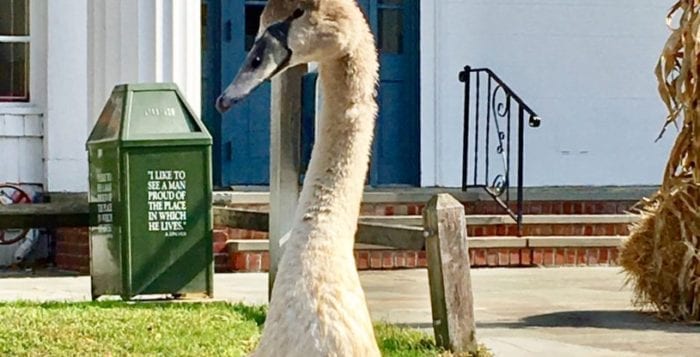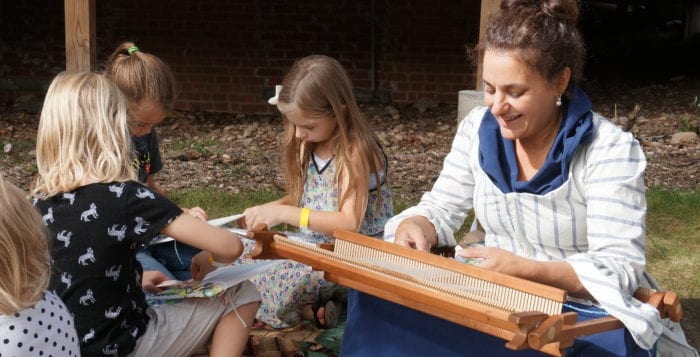A Setauket woman is doing her part to provide a best friend for someone in need in the form of a black lab/golden retriever puppy named Yucca II.
Since late July, Michele Galasso, 50, has been a volunteer puppy raiser for Canine Companions for Independence — a national nonprofit organization that matches highly trained assistance dogs to children and adults with disabilities at no cost to the recipients. And she couldn’t be happier.
“It’s wonderful and life affirming,” said Galasso. “I know the power and the beauty and the love that dogs bring to people — it’s an inspiring thing. It feels so good that I can help make that happen for a person.”
Ever since Yucca II turned 8 weeks old, it’s been Galasso’s job to take her into her home, raise her, teach her basic commands and socialization skills, and expose her to any and all types of surroundings by the time she leaves after 18 months of standard training.
From there, Galasso will return her puppy to CCI’s regional headquarters in Medford, where another six months of more advanced training will take place.
Ultimately, if Yucca II passes a rigorous evaluation process based on her different strengths, she can be matched with a person who might need her — a wounded veteran or an abused child, for instance.
CCI’s standards for the dogs are exceedingly high, with only about four out of 10 making it through the program, and so the puppy raisers are considered the backbones of the organization.
By the time they are fully trained, the dogs know more than 40 commands and be able to perform helpful tasks such as turn lights on and off, open and close doors, pick up dropped items and even help their human get dressed, according to John Bentzinger, CCI’s public relations coordinator.
“If you’re someone who wants to have some degree of independence … on command, these dogs can pick up an item as small as a dime and put it in your lap for you,” he said in a phone interview. “The more puppies being raised, the more people we can serve.”
Galasso said she was inspired to get involved with CCI when she met fellow dog lover Caryl Swain, who had been a longtime CCI puppy raiser. It was Swain who encouraged Galasso to attend a puppy training class at CCI, as well as a graduation ceremony in which diplomas were given out and leashes were ceremoniously handed over from the puppy raiser to the dog’s permanent recipient.
It was this ceremony that sealed the deal for Galasso.
“When I saw the individuals with their families receive their new service dogs, I knew that this was the service endeavor I have been searching for,” she said.
After a thorough interview process, including a rundown of all of her new responsibilities as a puppy raiser, like taking care of vet bills and food, and a long waiting period, CCI eventually told her to come pick up her puppy on July 29.
Galasso said that raising Yucca II is a lot of work but extremely rewarding. Yucca II is well mannered and loves working on her one-word commands, she said. Galasso puts a special yellow cape on Yucca II as she is permitted to go to many public areas that family pets aren’t allowed to, and visits the nearby senior center once a week.
To help the puppy adjust to a wide variety of surfaces, Galasso walks her indoors, outdoors, on the grass, in the street, as well as busy areas like Stony Brook Village. She’s also training her not to eat off the floor, in case the person she’ll assist were to drop their medication.
Galasso said that Yucca II loves people, especially children. On Halloween, she said Yucca II even sat in the middle of the stairs, which face a storm door with see-through glass only at the top of it, so she could look out and see the kids as they came up in their costumes.
“Sometimes I think, ‘Oh, I hope she gets placed with a child,’ because she really loves them.”
Last year in Mount Sinai, a young man named Shaun Egry — who suffers from cerebral palsy — was matched with an assistance dog from CCI. His mother Lisa said that they’ve been involved with CCI since 2004 and received their first dog in 2007 when Shaun was just 10 years old, confined to a wheelchair and in need of a friend.
She said the dogs have not only helped him physically, but emotionally too.
“He went from not speaking in public and being kind of embarrassed and ashamed to being very outgoing, and now he talks so much that he just doesn’t stop anymore,” said Lisa Egry. “It’s just a big confidence builder, and gave him what he needs to not feel so self-conscious of his disability.”
As a puppy raiser, Galasso knows that the toughest part of the job will be returning Yucca II back to headquarters, which she’ll have to do in February 2018. But it’s been stressed by CCI that a majority of the dogs are deemed unsuitable to be matched with anybody and, in that case, are then offered back to the puppy raisers as pets. Of course Galasso would be thrilled to bring Yucca II in permanently, she said, but she has faith that the puppy has what it takes to make it.
“My hope is that she succeeds through all her training and becomes an assistance dog,” said Galasso. “She’s a very special pup: She has a very sweet, easygoing temperament, she’s highly motivated to learn and she’s in excellent health. I just feel very strongly about the good that she can do for someone.”



 The National Association of Boards of Pharmacy (NABP) estimates that a large percentage of internet pharmacies are not in compliance with federal and state laws, or NABP safety and pharmacy practice standards. Some carry outdated, counterfeit, mislabeled or incorrect drug dosages. Others buy in such bulk (in order to offer discounted prices) that they are not able to store medications in appropriate environments. Rather, they are stored in conditions that are too hot, cold or humid. Many illegal online pharmacies can also put us at risk for credit card fraud or identity theft.
The National Association of Boards of Pharmacy (NABP) estimates that a large percentage of internet pharmacies are not in compliance with federal and state laws, or NABP safety and pharmacy practice standards. Some carry outdated, counterfeit, mislabeled or incorrect drug dosages. Others buy in such bulk (in order to offer discounted prices) that they are not able to store medications in appropriate environments. Rather, they are stored in conditions that are too hot, cold or humid. Many illegal online pharmacies can also put us at risk for credit card fraud or identity theft.



















